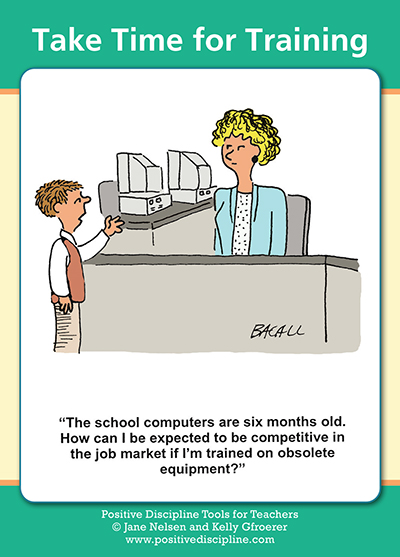
When I was an elementary school counselor and first tried to get students involved in class meetings, we were not successful. I thought the students just weren't ready; but it was me who wasn't ready. I didn't have a step-by-step plan for teaching the skills for class meetings, and I didn't understand that it would take time for the kids to practice and learn them. I needed to take time for training for myself first before I could help the students.
A huge part of taking time for training, is understanding that learning any skill requires a 3 step process:
1) a plan for training (a curriculum)
2) taking time to implement the plan
3) allowing time for mastery
Most teachers are very skilled at teaching academics and know how important it is to "take time for training" using the 3 step process. However, most teachers are not trained to teach social-emotional skills, so they don't realize that learning these skills also requires all three steps. Just as students don't master most academic subjects after just one lesson, it takes time to learn valuable social and life skills. Still, some teachers get frustrated and give up when they perceive students are not learning these skills quickly.
Class Meetings provide an excellent opportunity for children to learn valuable social and life skills.
Eight Skills for Effective Class Meetings
- Forming a circle.
- Practicing compliments and appreciations.
- Focusing on solutions.
- Role-playing and brainstorming.
- Respecting differences.
- Using respectful communication skills.
- Using the agenda and class meeting format.
- Understanding and using the mistaken goals.
Students need practice in all of these essential skills. Start with the first four:
- Take time for training by respectfully having your students brainstorm ways to form a circle quickly, quietly, and safely; and then let them practice their ideas until they can respectfully form a circle in less than a minute. For some this may be accomplished in a day or two. For others, mastery may take weeks.
- Take time for training students how to give and receive compliments. It can be helpful to model compliments and appreciations using specific wording: “I would like to compliment you for__________, OR “I appreciate __________”.
- Take time to practice brainstorming for solutions, including the use of the 3 R’s and an H for encouraging solutions: Related, Respectful, Reasonable, and Helpful.
- Use “fictional” but typical problems as a fun way to practice role-playing.
These are just four of the eight essential skills for successful class meetings that provide examples of the importance of a 3-step plan for Taking Time for Training. It is most important to note that learning does not take place by hearing lectures, but by taking time to teach skills and by allowing time for practice.
In today’s rushed world taking time for training is more important than ever. Slowing down to give students time for practice and mastery may go against the pressure you feel to get everything “covered”, but keep in mind the long-term results. One first grade teacher shared that it sometimes took the entire first month of school to teach her students the classroom procedures for their morning routine. But, taking the time to go step by step until there was mastery paid off the rest of the school year!



Comments
classroom meetings
Is it essential that children come to the circle in a certain amount of time (i.e., "less than one minute" per your article), or so quietly? Children have so much pressure on them already in many classrooms. I find that timing them to do this and doing it in silence is unnecessary; getting to the circle can be a moment of release instead of another time of having to behave in a certain prescribed way.
Getting into the class meeting circle
The point is not for them to have pressure, but to learn a skill in a way that is fun for them. It is best that the teacher does not time them, but that they have a student time them for the fun of it—and to then involve them if brainstorming for ways improve their skills. And, we always suggest that teachers use their wisdom and judgment. If noise doesn't bother you, then the quietly part can be eliminated. Involving students so they feel capable and connected is the key.